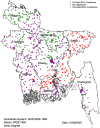Spatial variation in the non-use of modern contraception and its predictors in Bangladesh
- PMID: 37620501
- PMCID: PMC10449799
- DOI: 10.1038/s41598-023-41049-w
Spatial variation in the non-use of modern contraception and its predictors in Bangladesh
Abstract
This study aimed to investigate spatial variations in the non-use of modern contraception in Bangladesh and identify associated individual, household, and community-level factors. The analysis utilized data from 16,135 women, extracted from the 2017/18 Bangladesh Demographic and Health Survey. The study's main outcome was the prevalence of non-use of modern contraception (yes or no), while the explanatory variables included factors at the individual, household, and community level. To assess geographical heterogeneity in non-use of modern contraception, Moran's I statistics were applied. Additionally, the Gettis-Ord Gi* was calculated to measure spatial autocorrelation differences across various study locations. The relationship between non-use of modern contraception and location was further explored using a geographically weighted regression model at the cluster level. The results indicated that 42.8% (95% CI 41.6-43.8) of respondents reported non-use of modern contraception in Bangladesh, with significant variation across geographical locations (p < 0.001). Hot spots of high non-use were predominantly identified in the Sylhet, Barishal, and some areas of the Chattogram divisions, while cold spots of low use were concentrated in the Rangpur, Mymensingh, and some areas Rajshahi divisions. Notably, the likelihood of non-use was highest among women and partners with low levels of education. The analysis of other risk factors, such as partner occupation, community-level illiteracy, and poverty, revealed varying effects on non-use of modern contraception across different locations (clusters) within the country. The study's findings underscore the importance of targeted, area-specific policies and programs aimed at promoting knowledge and uptake of modern contraception in Bangladesh.
© 2023. Springer Nature Limited.
Conflict of interest statement
The authors declare no competing interests.
Figures




Similar articles
-
Clustering of home delivery in Bangladesh and its predictors: Evidence from the linked household and health facility level survey data.PLOS Glob Public Health. 2024 Feb 15;4(2):e0002607. doi: 10.1371/journal.pgph.0002607. eCollection 2024. PLOS Glob Public Health. 2024. PMID: 38359056 Free PMC article.
-
Spatial pattern and influential factors for early marriage: evidence from Bangladesh Demographic Health Survey 2017-18 data.BMC Womens Health. 2023 Jun 20;23(1):320. doi: 10.1186/s12905-023-02469-y. BMC Womens Health. 2023. PMID: 37340425 Free PMC article.
-
Exploring hot spots of short birth intervals and associated factors using a nationally representative survey in Bangladesh.Sci Rep. 2022 Jun 9;12(1):9551. doi: 10.1038/s41598-022-13193-2. Sci Rep. 2022. PMID: 35680970 Free PMC article.
-
Exploring spatial variations in level and predictors of unskilled birth attendant delivery in Bangladesh using spatial analysis techniques: Findings from nationally representative survey data.PLoS One. 2022 Oct 25;17(10):e0275951. doi: 10.1371/journal.pone.0275951. eCollection 2022. PLoS One. 2022. PMID: 36282794 Free PMC article.
-
Spatial variations in family planning demand to limit childbearing and the demand satisfied with modern methods in sub-Saharan Africa.Reprod Health. 2022 Jun 22;19(1):144. doi: 10.1186/s12978-022-01451-5. Reprod Health. 2022. PMID: 35733204 Free PMC article.
Cited by
-
Association between women's empowerment and use of modern contraception methods in Bangladesh: evidence from Bangladesh demographic and health survey 2022.Contracept Reprod Med. 2025 Jul 18;10(1):41. doi: 10.1186/s40834-025-00383-2. Contracept Reprod Med. 2025. PMID: 40682157 Free PMC article.
References
-
- Assembly G. Sustainable development goals. In SDGs Transform Our World 2015 (2030).
-
- United Nations. World Family Planning. In: The Department of Economic and Social Affairs, New York, USA (2017).
-
- WHO. Family Planning/Contraception Methods. (WHO, 2020).
-
- Bearak J, Popinchalk A, Ganatra B, Moller A-B, Tunçalp Ö, Beavin C, Kwok L, Alkema L. Unintended pregnancy and abortion by income, region, and the legal status of abortion: estimates from a comprehensive model for 1990–2019. Lancet Glob. Health. 2020;8(9):e1152–e1161. doi: 10.1016/S2214-109X(20)30315-6. - DOI - PubMed
-
- National Institute of Population Research and Training (NIPORT) MaA, and ICF International. Bangladesh Demographic and Health Survey 2017/18. (NIPORT, Mitra and Associates, and ICF International, 2021).
Publication types
MeSH terms
LinkOut - more resources
Full Text Sources
Medical

